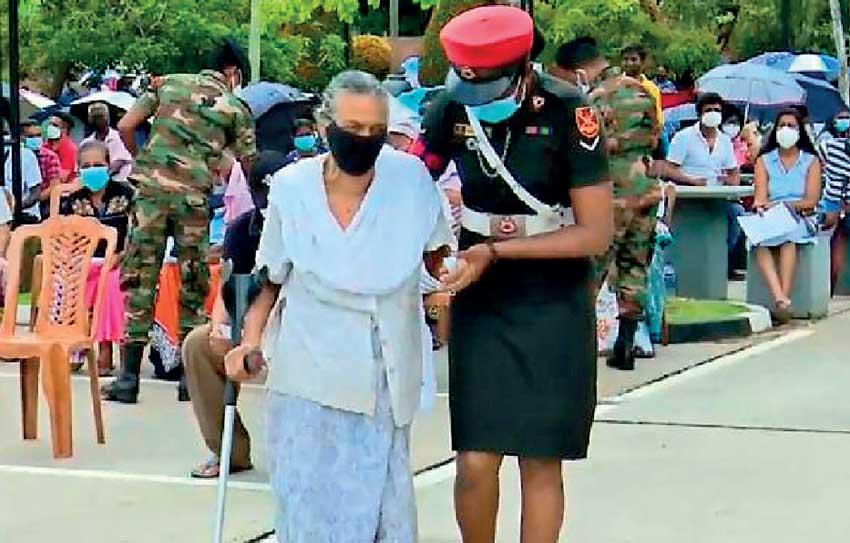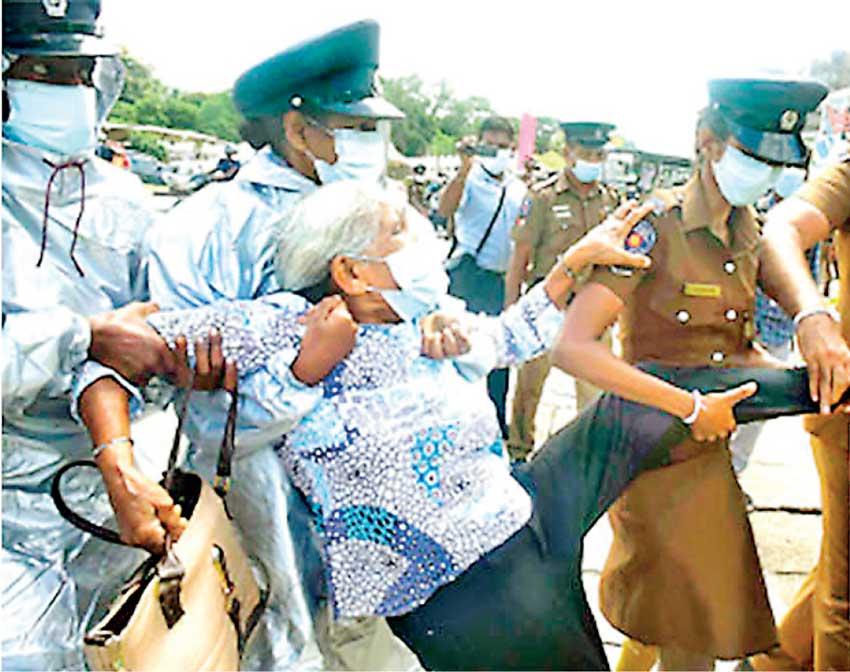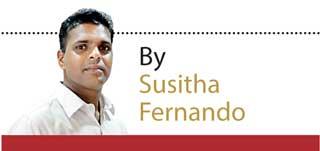Reply To:
Name - Reply Comment

An Army Military Police officer helps an elderly lady at a vaccination centre on July 8

An elderly protester at July 8 protest in Battaramulla being carried by police to be loaded to a bus
Hats off to the Sri Lanka tri-forces! All in all it definitely created a positive vibrant among the ordinary public; even by people who oppose the much criticised ‘militarisation’ of the country
Unfortunately on the same day, at Battaramulla junction, we saw a diametrically opposite show by the Police where law enforcement officers violently fought protests initiated by teachers and undergraduates
It was a coincident and ironical that while the violent control of protesters in Sri Lanka was taking place on July 8, on the same day the United Kingdom’s annual report on human rights and democracy ruled that the overall human rights situation in Sri Lanka continued to deteriorate in 2020
 On July 8 (Thursday) we saw diametrically opposite results because the security forces are apparently being used for the government’s objectives. In a number of security forces camps around the country vaccination programmes were conducted with the participation of security personnel. With the true to life security forces discipline we saw how well organised the inoculation programmes were. On television we saw an aerial video footages taken from drone cameras, probably provided by the Army Media unit, how systematically physical distancing was maintained at those centres. It was heartening to see how the vaccines were given even keeping elderly religious dignitaries in their vehicles and also security forces medical corps going to queues where there were feeble elders. Hats off to the Sri Lanka security forces! All in all it definitely created a positive vibrant among the people; even by those who oppose the much criticised ‘militarisation’ of the country. After all, most of those young members of the security forces are sons and daughters of parents living in rural remote areas of Sri Lanka. The troops came forward to protect the country and its people.
On July 8 (Thursday) we saw diametrically opposite results because the security forces are apparently being used for the government’s objectives. In a number of security forces camps around the country vaccination programmes were conducted with the participation of security personnel. With the true to life security forces discipline we saw how well organised the inoculation programmes were. On television we saw an aerial video footages taken from drone cameras, probably provided by the Army Media unit, how systematically physical distancing was maintained at those centres. It was heartening to see how the vaccines were given even keeping elderly religious dignitaries in their vehicles and also security forces medical corps going to queues where there were feeble elders. Hats off to the Sri Lanka security forces! All in all it definitely created a positive vibrant among the people; even by those who oppose the much criticised ‘militarisation’ of the country. After all, most of those young members of the security forces are sons and daughters of parents living in rural remote areas of Sri Lanka. The troops came forward to protect the country and its people.
Unfortunately on the same day, at Battaramulla junction, we saw a diametrically opposite show by the Police where law enforcement officers violently suppressed protests initiated by teachers and university students. They were not directly protesting against the government’s political conduct, but to protect the rights of all for equal opportunities in education and demanding that the Kotelawela Defence University Bill be scrapped. The students alleged that the Bill was the first step towards the privatisation of education.
A large number of police personnel carried and dragged protesters who resisted the police move to remove them from the vicinity. It was also disgusting to see how some Police personnel dragged elderly females from her legs and limbs while some female protesters whose clothes were torn to pieces were loaded to a bus.
The cameras also captured how a protesting monk whose saffron robe was torn, was carried from his legs and hands and dumped into a bus. Feelings of any Sri Lankan belonging to whatever religion, let alone Buddhism, would have been disturbed watching the way in which the venerable monk was carried away by the police.
Not only the protesters, a video journalist who went to cover the protest too was attacked by a police woman who later ran away from the scene. It was a horrible attack by the police and a clear black mark on an institution which is maintained by the government at public expense.
Following the dispersing of protesters the opposition parliamentarians got on to the street at Battaramulla and protested. They demanded that they too be arrested by the police. They charged that quarantine regulations had been misused to control protests that were carried out by the farmers who were making genuine demands regarding the non-availability of fertilizer, the fishermen who have taken to the street against oil price hikes and teachers and students who have come forward to protect education rights.
Question are also being raised as to why and how the celebrations were allowed all over the country to mark the appointment of Basil Rajapaksa as Finance Minister. During those celebrations also health guidelines were not followed. These celebrations did happen in the presence of the same police, who violently dispersed protests elsewhere.
Arrested protesters were later produced before Colombo Magistrate and were released on bail. The Magistrate also turned down the request by the Police to send the protesters on quarantine. The court observed that sending or not sending the protesters on quarantine was a decision that should be taken by the health authorities.
If the request from the Magistrate was genuine and for health reasons it was not only the protesters, but all the policemen too should have been sent on quarantine. The law enforcement officers were seen manhandling the protesters.
Joseph Stalin taken in However, the police using force started to load the bailed out protesters to a bus to be sent on quarantine and a tense situation ensued in front of the Hulftsdorp Courts. After a scuffle and the manhandling the police managed to load 16 protesters including Ceylon Teachers’ Union General Secretary Joseph Stalin. They were packed off to an Air force camp in Mullaitivu for a 14-day quarantine period, to ensure that at least those sent on quarantine would not get on to the street for the next two weeks.
It was reported that two female protesters, who were sent on quarantine, were not allowed to change their clothes; something totally different to what happened when the so called model Piyumi Hansamali was taken away for quarantine. The artiste had allegedly violated health guidelines by taking part at a birthday party at Shangrila Hotel. The media inquiries later revealed that it was on the direction of Public Security Minister Sarath Weerasekara that the bus carrying Hansamali was stopped to provide some clothes to her before starting the quarantine period.
Yesterday (July 9) former Prime Minister and United National Party (UNP) MP Ranil Wikcremesinghe warned that such a violent reaction to protests might trigger off an international response which would affect the Government negatively. Experienced politician Wickremesinghe stressed that someone like the Teachers’ Union General Secretary Joseph Stalin was even known in Geneva and the arrest of such a person would in the long run affect Sri Lanka’s human rights situation. He said that it might even affect the GSP plus facility which the Government of Sri Lankan is desperately trying to secure.
It was a coincident and ironical that while the violent control of protesters in Sri Lanka was taking place on July 8, on the same day the United Kingdom’s annual report on human rights and democracy ruled that the overall human rights situation in Sri Lanka continued to deteriorated in 2020. “An alleged increase in surveillance and intimidation of civil society, limited or no progress with regard to accountability, militarisation and other issues,” said the ‘Human Rights and Democracy: 2020 Foreign, Commonwealth & Development Office report’.
“The Government delivered free and peaceful parliamentary elections despite the COVID-19 pandemic, and maintained low numbers of COVID-19 cases compared to global figures. However, there was increased surveillance and intimidation of civil society, constraints placed on communities practising religious burial rites, a number of lengthy detentions without charge, and several setbacks on post-conflict accountability and reconciliation.
At the UN Human Rights Council in February, the Sri Lankan Government withdrew its support for resolutions 30/1, 34/1, and 40/1 on post-conflict transitional justice, accountability and reconciliation. Although it announced its commitment to a domestic mechanism for reconciliation and accountability, there was no progress on this. The UK made clear its commitment to reconciliation and accountability in statements delivered on behalf of the Core Group on Sri Lanka at the HRC in February, June and September.
Sri Lanka’s commitment to accountability was further called into question in March when President Rajapaksa pardoned and released former Army Staff Sergeant Sunil Ratnayake, who was convicted in 2015 for the murder of eight civilians (including children) in Jaffna in 2000. The President continued to appoint controversial military figures accused of war crimes to government roles, while civilian functions such as the Secretariat for Non-Governmental Organizations were brought under the control of the Ministry of Defence,” the report noted.
The chapter on Sri Lanka ended stating “In 2021, the UK will continue to press for progress on human rights, gender equality and protections for minorities and vulnerable groups. We shall continue to invest in ambitious programmes which support conflict-affected communities, promote the role of civil society, facilitate social cohesion, and underline the critical importance of post-conflict reconciliation and accountability,”.
At a time when Sri Lanka is caught up in one of the worst financial crisis in its history, it is the duty of the government not to further antagonise the international community, but see that it maintains human rights and ensure it is genuinely interested in issues of the people.
For this to happen Government needs to be advised by rational thinking civic rights conscious people.